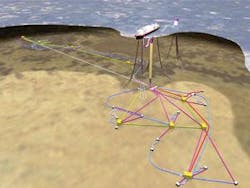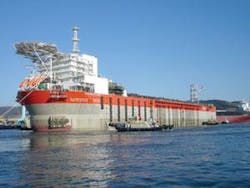BP’s Greater Plutonio cluster development may set stage for more
Standardization shortens construction schedule
Jeremy Beckman, Editor, Europe,
Greater Plutonio, due onstream next year, could be the first of several cluster developments for BP offshore Angola. All are located in deepwater blocks 18 and 31, where the company has drilled a long sequence of discoveries since 1999.
BP also partners with ExxonMobil and Total in projects already in production in nearby blocks. Experience from Girassol in particular has been factored into Greater Plutonio’s subsea concept.
BP was one of the first majors to recognize Angola’s deepwater potential. Initially, it acquired non-operated equity in the mid-1990s in blocks 15 and 17, via a joint venture with Statoil. Even then, its longer-term interest was in the unlicensed ultra-deep acreage to the west. However, its first operated deepwater block - 18 - was inherited following the merger with Amoco in 1998.
The Amoco team in Houston had already embarked on seismic and exploration drilling. After an extended period of consolidation and global asset reviews, BP decided to resume that work, transferring Amoco’s block 18 expertise to London. In May 1999, the company also won operatorship of Angolan ultra-deep block 31.
Block 18 covers an area of 4,880 sq km, in water depths varying from 500 m toward the coast, to 1,600 m out west. Between 1991 and 2001, BP’s exploration focus was on the northwestern part of the block.
Drilling yielded six discoveries in water depths of 1,200-1,500 m - Cobalto, Cromio, Galio, Paladio, Platina, and Plutonio - in an area around 150 km offshore. All the fields contained commercial quantities of oil and associated gas. As anticipated from early seismic data, the most productive zones proved to be the Miocene and Oligocene, at relatively shallow sub-surface depths (2,000 m to 3000 m).
Unlike blocks 15 and 17, there was no obvious location for a host processing platform or FPSO, the fields being of similar size and fairly widely spread. For Galio and Platina, long subsea tiebacks appeared unavoidable, leading to further concerns over insulation.
According to BP’s senior adviser for subsea and deepwater engineering David Brookes, the block 18 partners deliberated long and hard over the next couple of years, evaluating six different development arrangements.
“Early on, we considered a similar concept to ExxonMobil’s in block 15, based around a TLP,” Brookes said. “But due to the dispersed nature of our fields, there was nowhere we could anchor a facility with dry wells, which meant we had to go for a wet [subsea] system. We then looked at tying everything back to one big hub, but the distances were too great. Based on our knowledge of deepwater flow assurance in 2002, we decided to limit maximum flow-back distances to 25 km.”
Eventually, BP and its partner Shell - since replaced by Sonangol Sinopec International - opted for a single spread-moored FPSO in between the Plutonio, Paladio, and Cobalto fields. Cromio and Galio, to the northwest, would be linked in via a separate, 21.2-km flowline, with options to tie-in additional fields in the future.
Early in 2004, BP issued the main development contracts. Kellogg Brown & Root in Leatherhead, UK was entrusted with engineering and procurement of the topsides facilities, and support for the BP project management team.
Hyundai Heavy Industries gained the $350-million contract for the FPSO hull and topsides assembly. Last summer, the completed hull left its drydock in Ulsan, South Korea, and is now being outfitted with topsides modules.
The 310-m long, 58-m wide vessel will have crude processing capacity of up to 220,000 b/d, probably more than enough for the five phase 1 fields. It will also have storage capacity of up to 2 MMbbl. As on Girassol, oil will be exported to shuttle tankers via a CALM buoy.
The vessel’s topsides will include modules for gas and water injection. Water injection will be needed for lift purposes in all the reservoirs; associated gas will be re-injected into the Plutonio reservoir until called on for Angola’s first offshore gas-gathering scheme. Coordinating operator Chevron is working toward a start-up date of 2010.
Stolt Offshore and Technip were jointly awarded the contract for the umbilicals, flowlines, and risers. As with the Girassol FPSO, which is moored in similar water depths, incoming production will pass through a self-standing, 4,000 metric ton bundled riser tower, assembled locally at Sonamet’s yard in Lobito.
The tower structure, encasing three production risers, will be connected to the FPSO via flexible pipes. The risers will be linked to a network of flow lines tying in 43 subsea wells, one of the biggest and most complex schemes attempted by BP anywhere. The semisubmersibleSedco Expressstarted the five-year development drilling program last summer.
FMC Kongsberg won the design competition for the subsea trees and associated manifolds and control systems. These will be conventional vertical trees. BP considered equipping the wells with distributed temperature sensors. However, although the trees will support this capability, the company decided not to employ it for the first wave of wells, due to the technology being immature. It may be used at some later stage.
BP says that what really differentiates Greater Plutonio from other projects in the region with long-distance tiebacks, such as Kizomba, Girassol, and Rosa/Lirio, is the inclusion of two looped flowline systems. This design allows for reverse flow for pigging/flooding operations.
BP opted for a fully insulated loop for the flowlines for the southern part of the field. However, as part of an overall drive to contain the project’s costs, displacement fluids will be supplied to the northern part of the field through a plain, non-insulated carbon steel service line connecting to the furthest point of the insulated line.
BP does not view pushing the boundaries of deepwater subsea production as an end in itself. It believes there is a tendency to over-design in many cases, leading to a very high level of insulation for flowlines and risers. Much of BP’s in-house R&D centers on what it can do to cut back on this type of conservatism.
The Greater Plutonio flowlines are 12-in. diameter and will be protected by glass-sphere syntactic polypropylene applied at Socotherm’s marine base in Vitória, Brazil.
“We went for one of the thickest insulation materials available,” Brookes points out. “We purposely avoided use of pipe-in-pipe. Although we have used this extensively in the Gulf of Mexico, you pay a penalty in terms of added price.”
BP has learned from an unplanned production shutdown onGirassol, where a convection effect built up in the insulation system. This was noticeable particularly in the riser towers, where the pipe-in-pipes suffered notable convection heat losses.
Greater Plutonio’s riser tower, on the other hand, will only incorporate wet insulation - with no pipe-in-pipes - so there should be no convection effect following a shutdown. For a temporary closure, the plan would be to launch a pig through the service line or loop to flush out the flowlines. If the situation reached the point of no return, the company would flush out the entire system firstly with diesel, and then with treated crude.
Block 31 extends across 5,350 sq km, in water depths ranging from 1,500 m to 2,500 m. BP operates with 26.67%, partnered by Esso (25%), Sonangol (20%), Statoil (13.33%), Marathon (10%), and TEPA (Block 31) Ltd. (5%).
BP began exploration drilling in September 2002 with the semisubmersible Leiv Eriksson. Initially, the focus was on the north-eastern part of the block, in water depths of around 1,800 m. This campaign brought immediate dividends with the Plutao oil discovery, followed by Saturno, Venus and Marte in 2003, all within 10-15 km of each other.
In 2004, BP returned to block 18 with the same rig, registering new oil discoveries in the far west of the block, Cesio and Chumbo, the latter located 10 km southwest of Platina. Last year, the company switched its attention to the southeastern corner of block 31, achieving five more oilfield finds, in water depths ranging from 1,500 m (Astraea) to over 2,000 m (Hebe).
BP did consider adding Cesio and Chumbo to theGreater Plutonio scheme, but tieback distances, and lack of available ullage until 2013-14 on the Greater Plutonio FPSO, militated against this.
It expects the next series of floaters to be smaller, as it reckons that very large FPSOs, including its own and those serving on Kizomba and Girassol, have turned out to be pretty expensive on a pro rata basis.
While allowing for some flexibility on throughput - depending on limiting factors such as oil, gas and water - the intention is to standardize as much as possible on these developments. This philosophy extends to topsides and subsea equipment.
In practice, this might mean similar-size FPSOs, capable of processing 100-150,000 b/d, possibly less on block 18 West where resources are smaller.
“Similar FPSOs also afford greater opportunities for conversions from new hulls, which in turn should shorten the construction schedule,” Brookes points out. BP is also keen on limiting the topsides arrangement to a single tier.
Each cluster could conceivably be developed through 25-35 subsea wells. Over the long term, BP anticipates around 130 (more from future infills and replacements) subsea wells across the two blocks. These could be serviced by light well intervention, performed from a dedicated workboat with a moonpool. One option under discussion is a timeshare with other block operators in the region.
Riser towers, however, may not feature in the new development projects. BP would prefer a simpler system, maybe even one that is less proprietary. Riser towers are not ruled out, but the company prefers a standalone concept.•


